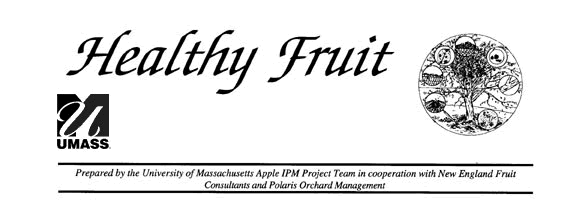
|
|
|---|
Second-generation leafminer adults have begun to emerge statewide, making it a good time to sample for the presence of tissue-feeding mines in order to get a read on the level of control gained from first-generation management. Given the staggering early-season trap captures, we felt that leafminers would pose a serious threat to many orchards this season, even in the face of chemical control. However, samples over the past week have revealed a level of LM control (principally by use of Provado) which is nothing short of remarkable. In a test of spray timing in Conway, a high level of LM control was achieved by either of two approaches; both a petal fall application and a one-week delayed application offered nearly perfect results.
Despite excellent control in most treated orchards, moderate infestation of first-generation mines can lead to problems late in the year, as was the case last season. Particularly in blocks that did not receive early-season LM treatment, we highly recommend that growers keep an eye on the development of the second generation, and treat with Provado, SpinTor, or Lannate if necessary. To determine if second-generation treatment is needed, we recommend a threshold of 50 mines per 100 leaves (for McIntosh) or 100 mines per 100 leaves (for non-McIntosh varieties). As with first-generation management, treatment should be made as early as possible against the sap-feeding LM larvae.
Last season, many orchards experienced moderate buildup of San Jose scale, an intermittent pest in Massachusetts commercial orchards. This accumulation of SJS was generally attributed to poor (or no) oil coverage during the wet spring of 1998, which is the first step in avoiding development of perennial infestation. If SJS presence was noted on fruit at harvest last season, it is best to keep an eye out for a return showing. In blocks where this pest is becoming an issue, a treatment with Lorsban in the next couple of weeks should clear up any developing problems.
As mentioned regularly in discussions of mite management, hot weather can lead to more rapid breakdown of early-season control measures and accumulation of damaging mite populations. In addition to development of a higher population, dry conditions inspire mites to feed more aggressively (to gain necessary moisture), putting additional strain on mite-infested trees. While the season thus far has not been particularly warm, it certainly has been dry, and some tree stress and bronzing has been observed.
As the ERM population begins to build, we recommend regular foliar monitoring, and that summer treatment be considered if more than 50% of middle-aged fruit cluster leaves are found infested (threshold applies through the end of June, developed in New York). To reiterate, we recommend either Pyramite or Apollo as rescue treatments, though Kelthane and Carzol are also labeled for use.
Immigration into blocks of apple trees by adult rose leafhoppers is tailing off, and egglaying has begun in earnest. In roughly two weeks, early RLH/WALH nymphs should be visible on middle-aged terminal foliage, which will indicate the ideal time to treat. If this generation's nymphal presence indicates development of an intolerable population, treatment with Thiodan or Sevin should clean up the problem before it gets too severe.
This is also a good time to look over young plantings for the presence of potato leafhopper nymphs, which are generally active on the youngest terminal foliage. PLH nymphs can be distinguished from RLH/WALH by their color (light green for PLH vs. white to yellow for RLH/WALH), and their style of movement (generally sideways, like a crab). If treatment is warranted against PLH nymphs, a late-June treatment with either Thiodan or Sevin should be highly effective.
Although a few apple maggot flies have been captured over the past week in curculio traps, emergence of AMF adults is generally slowed by dry soil conditions. Rain over the next couple of weeks will likely stimulate more widespread emergence, and placement of monitoring spheres in early July should offer a good indication of their level of abundance. Spheres and tangletrap can be purchased from a number of vendors, including Gempler's (Belleville, Wisconsin), Great Lakes IPM (Vestaburg, Michigan), and OESCO (Conway, Massachusetts). A complete listing of supply and vendor information is posted in the 1999 March Message.
Healthy Fruit is written by Dan Cooley, Ron Prokopy, Starker Wright, Wes Autio, and Duane Greene except where other contributors are noted. Edited by Dan Cooley. Publication is funded in part by the UMass Extension Agroecology Program, grower subscriptions, and the University of Massachusetts IPM Program. A text version can be e-mailed to you if you contact Doreen York. Please cite this source if reprinting information.